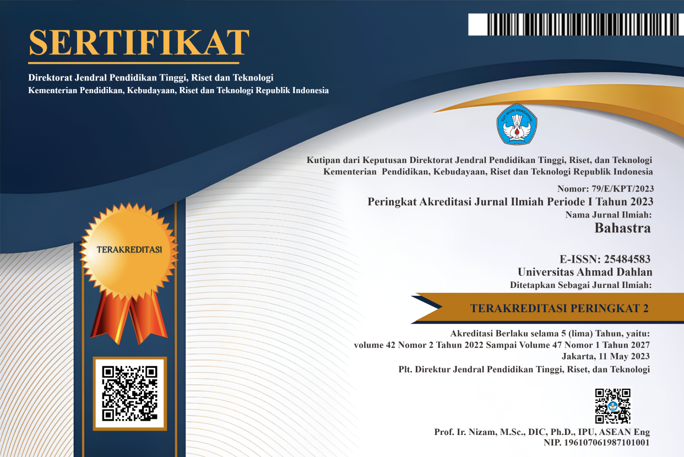The language forms of Instagram netizens’ rejection toward Rohingya immigrants in Aceh Province
DOI:
https://doi.org/10.26555/bs.v44i1.701Keywords:
language of rejection, metaphor, speech acts, RohingyaAbstract
The research examines the expressions of rejection used by Instagram users against Rohingya immigrants in Aceh Province. This study is grounded in the growing public apprehension surrounding the influx of Rohingya immigrants, which has been steadily rising over time. The current population of Rohingya immigrants in Indonesia is 1,600, since their initial arrival in Aceh in 2009. This instigates social and economic strife, in which the state of prosperity for the Acehnese population remains incomplete. The data source for this research is 500 comments from Instagram users on five posts on multiple Instagram media profiles. The research data was acquired in December 2023 and subsequently examined using a qualitative descriptive methodology. According to the study's findings, the most common form of rejection was one that used suggestions or other alternatives. It indicates that the individuals in Aceh exhibit a high degree of empathy; however, due to various conditions, they suggest alternative resolutions. Meanwhile, the most minimal form is rejection accompanied by gratitude. These findings demonstrate that Instagram users consider it unnecessary to use courteous language and consider it acceptable to reject Rohingya immigrants. This research also indicated that technological innovations have contributed to the advent of forms of language rejection. We have discovered novel types of rejection discourse, specifically employing symbols or emoticons, utilizing metaphors, and employing hashtags to exert influence over fellow Instagram users.
References
Abik, H. (2020, September 27). Sejarah kedatangan pengungsi Rohingya di Aceh, terusir dan menjadi etnis paling teraniaya di dunia. Serambi Indonesia. https://serambiwiki.tribunnews.com
Al-Mahrooqi, R., & Al-Aghbari, K. (2016). Refusal strategies among omani EFL students. SAGE Open, 6(4). doi: 10.1177/2158244016672907
Al Marjuk, O. (2022). Ethnicity, identity, and Rohingya security: At the ‘Olive Tree’–‘Lexus’ crossroads BT - Rohingya camp narratives: Tales from the ‘Lesser Roads’ traveled (I. A. Hussain (ed.)). Springer Nature Singapore. doi: 10.1007/978-981-19-1197-2_2
Allen, K. A., Gray, D. L., McInerney, D. M., Ryan, T., & Waters, L. (2014). Social media use and social connectedness in adolescents: The positives and the potential pitfalls. The Australian Educational and Developmental Psychologist, 31(1), 18–31. doi: 10.1017/edp.2014.2
Anthony, L. (2012). AntConc. http://www.antlab.sci.waseda.ac.jp
Baldridge, D. C., & Veiga, J. F. (2001). Toward a greater understanding of the willingness to request an accommodation: Can requesters’ beliefs disable the Americans with disabilities act? Academy of Management Review, 26(1), 85–99. doi: 10.5465/amr.2001.4011956
Baškarada, S., & Koronios, A. (2018). A philosophical discussion of qualitative, quantitative, and mixed methods research in social science. Qualitative Research Journal, 18(1), 2–21. doi: 10.1108/QRJ-D-17-00042
BBC. (2023, November 26). Rohingya negara mana? dan tujuh hal mengenai Rohingya. https://www.bbc.com/indonesia/articles/cjkp8nkp0gyo
Busri, R. V., & Massagun, M. (2023). Bentuk ungkapan penolakan dalam penggunaan bahasa Indonesia pada mahasiswa STIT Hamzah Fansuri Subulussalam Aceh. Jurnal Review Pendidikan dan Pengajaran, 62, 1502–1512. doi: 10.31004/jrpp.v6i4.21081
Carr, C. T., & Hayes, R. A. (2015). Social media: Defining, developing, and divining. Atlantic Journal of Communication, 23(1), 46–65. doi: 10.1080/15456870.2015.972282
Chang, Y. F. (2009). How to say no: An analysis of cross-cultural difference and pragmatic transfer. Language Sciences, 31(4), 477–493. doi: 10.1016/j.langsci.2008.01.002
Christakis, N. A., & Fowler, J. H. (2013). Social contagion theory: Examining dynamic social networks and human behavior. Statistics in Medicine, 32(4), 556–577. doi: 10.1002/sim.5408
Dapubeang, A. R. A. P. (2020). Bentuk bahasa penolakan kaum muslim terhadap tawaran makan dari kaum nasrani di Kota Kupang. Jubindo: Jurnal Ilmu Pendidikan Bahasa dan Sastra Indonesia, 5(1), 19–29. doi: 10.32938/jbi.v5i1.476
Ehmer, E., & Kothari, A. (2021). Malaysia and the Rohingya: Media, migration, and politics. Journal of Immigrant & Refugee Studies, 19(4), 378–392. doi: 10.1080/15562948.2020.1821274
Eliya, I., Santoso, A., & Taufiqurrahman, F. (2023). Perundungan siber sebagai praktik kejahatan berbahasa dalam akun instagram Puan Maharani. Widyaparwa, 51(1), 149–160. doi: 10.26499/wdprw.v51i1.1219
Gürtler, K. (2023). Justice in energy transformations as a spatial phenomenon: A framework for analyzing multi-dimensional justice claims. Energy Research & Social Science, 105, 103277. doi: 10.1016/j.erss.2023.103277
Guzik, P. (2018). Communicating migration – Pope Francis’ strategy of reframing refugee issues. Church, Communication and Culture, 3(2), 106–135. doi: 10.1080/23753234.2018.1478230
Han, D. (2023). 6: The Role of the Malaysian armed forces in defence diplomacy: A foreign policy outworking of civil–military relations in Malaysia. Bristol University Press. doi: 10.51952/9781529229349.ch006
Hermaji, B. (2011). Tindak tutur penerimaan dan penolakan dalam bahasa Indonesia. Cakrawala: Jurnal Pendidikan, 7(1), 18–27. doi: 10.24905/cakrawala.v7i1.59
Islam, N. (2020). Rohingya: A people Under Endless Tyranny. Asian Affairs: An American Review, 48(1), 14–40. doi: 10.1080/00927678.2020.1793631
Kana, M. (1982). Saying no in English. Relc Journal, 13(2), 29–50. doi: 10.1177/00336882820130020
Kartomihardjo, S. (1990). Bentuk bahasa penolakan (Penelitian sosiolinguistik). IKIP Malang.
Kipgen, N. (2019). The Rohingya crisis: The centrality of identity and citizenship. Journal of Muslim Minority Affairs, 39(1), 61–74. doi: 10.1080/13602004.2019.1575019
Maemunah, E. (2014). Bentuk tindak tutur penolakan pada novel “Ayat-Ayat Cinta” karya Habiburrahman El Shirazy. Medan Makna: Jurnal Ilmu Kebahasaan dan Kesastraan, 1(1), 10–22. doi: 10.26499/mm.v12i1.1020
McFarland, L. A., & Ployhart, R. E. (2015). Social media: A contextual framework to guide research and practice. Journal of Applied Psychology, 100(6), 1653–1677. doi: 10.1037/a0039244
Milton, A. H., Rahman, M., Hussain, S., Jindal, C., Choudhury, S., Akter, S., Ferdousi, S., Mouly, T. A., Hall, J., & Efird, J. T. (2017). Trapped in statelessness: Rohingya refugees in Bangladesh. In International Journal of Environmental Research and Public Health, 14(8). doi: 10.3390/ijerph14080942
Mukhamdanah, & Inayatusshalihah. (2020). Tuturan penolakan oleh penutur bahasa Komering di Pulau Gemantung, Ogan Komering Ilir. Widyaparwa, 48(2), 122–132. doi: 10.26499/wdprw.v48i2.542
Mukhlis, & Rusli, H. (2023). Exploring the roots of social conflict and its resolution in Aceh through the study of the hikayat Pocut Muhammad: Cultural literacy. Atlantis Press SARL.
Nadar, F. X., Wijana, I. D. P., Poedjosoedarmo, S., & Djawanai, S. (2005). Penolakan dalam bahasa Inggris dan bahasa Indonesia. Humaniora, 17(2), 166–178. doi: 10.22146/jh.842
Nurbaiti, F. (2017). Bentuk-bentuk tuturan penolakan cinta dalam bahasa Indonesia dan faktor sosial yang memengaruhinya: Analisis sosiolinguistik. Etnolingual, 1(2), 101–124. doi: 10.20473/etno.v1i2.7396
Nursyazwani, & Abd Jalil, A. (2023). Grateful politics: Rohingya and social media in the time of the pandemic BT - new media in the margins: Lived realities and experiences from the Malaysian peripheries (B. Y. H. Loh & J. Chin (ed.). Springer Nature Singapore. doi: 10.1007/978-981-19-7141-9_5
Pratiwi, H., & Ramdani, S. D. (2021). Analisis bentuk bahasa penolakan dalam transaksi jual beli online. KODE: Jurnal Bahasa, 11, 161–173. doi: 10.24114/kjb.v10i3.28313
Robbins, L. (2020). The Rohingya case in Aceh: Indonesia’s role as a destination for refugees. Towson University Journal of International Affairs, 3(LIII), 1–15. https://wp.towson.edu/iajournal/articles/2010-2019/spring-2020/10535-2/
Sahana, M., Jahangir, S., & Anisujjaman, M. D. (2019). Forced Migration and the expatriation of the Rohingya: A demographic assessment of their historical exclusions and statelessness. Journal of Muslim Minority Affairs, 39(1), 44–60. doi: 10.1080/13602004.2019.1587952
Sattar, H. Q. A., Lah, S. C., & Suleiman, R. R. R. (2011). Refusal strategies in english by Malay university students. GEMA Online Journal of Language Studies, 11(3), 69–81. https://www.researchgate.net/publication
Sugiyono. (2015). Metode penelitian kombinasi (Mix methods). Alfabeta.
Surun, L.R., S., Kunci, K., & Rohingya, dan. (2022). Pengaruh konflik Rohingya Myanmar terhadap stabilitas keamanan Asia Tenggara. Journal of International and Local Studies, 6(1), 1–7. doi: 10.56326/jils.v6i1.1240
Umale, J. (2011). Pragmatic failure in refusal strategies: British versus Omani Interlocutors. Arab World English Journal, 2(1), 18–46. https://awej.org
Usman, A. R., Sulaiman, A., Muslim, M., & Zulyadi, T. (2023). Conflict and cultural adaptation of the Aceh Rohingya refugees in media opinion. Profetik: Jurnal Komunikasi, 16(1), 109. doi: 10.14421/pjk.v16i1.2491
Vincent, B. C., & Mgaya, O. P. (2022). The massive influx of global refugees from developing nations: An existing Gap in the United Nations role in promoting Universal Human Rights. International Journal of Poverty, Investment and Development, 2(1 SE-Articles), 62–87. doi: 10.47941/ijpid.1114
Warren, A. M., Sulaiman, A., & Jaafar, N. I. (2014). Social media effects on fostering online civic engagement and building citizen trust and trust in institutions. Government Information Quarterly, 31(2), 291–301. doi: 10.1016/j.giq.2013.11.007
Yusuf, Y., Amiruddin, M. H., & Gade, S. (2020). Educational value of Tauhid In Acehnese Poem “Ratéb Dôda Idi” study of local wisdom in Aceh Besar community. Fitrah: Jurnal Kajian Ilmu-ilmu Keislaman, 6(1), 1–18. doi: 10.24952/fitrah.v6i1.2484

Downloads
Published
Issue
Section
License
Copyright (c) 2024 Rahmad Nuthihar, Ramli Ramli, Herman Rusli, Ixsir Eliya

This work is licensed under a Creative Commons Attribution-ShareAlike 4.0 International License.


1.jpg)







